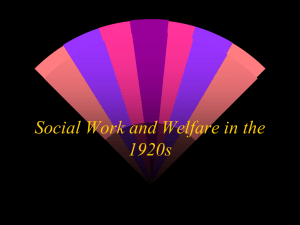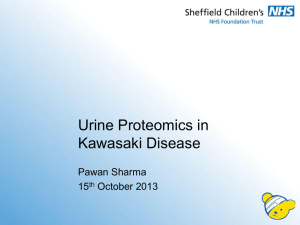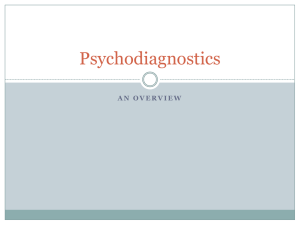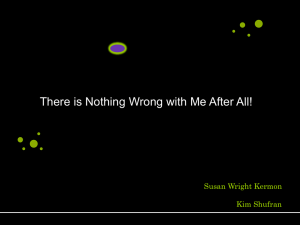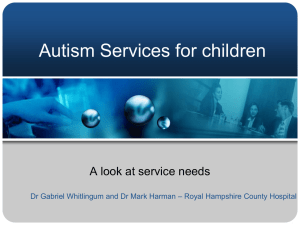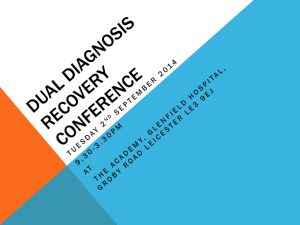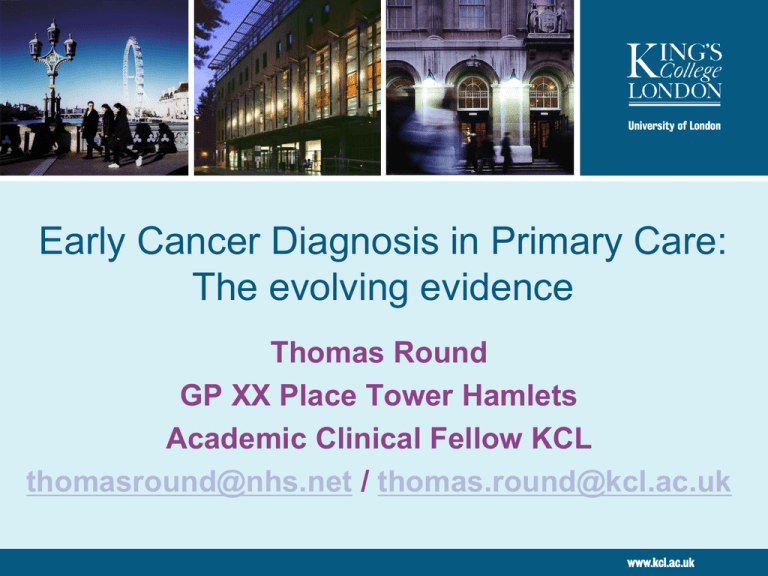
Early Cancer Diagnosis in Primary Care:
The evolving evidence
Thomas Round
GP XX Place Tower Hamlets
Academic Clinical Fellow KCL
thomasround@nhs.net / thomas.round@kcl.ac.uk
Or
“Spotting the needle in the haystack”
Presented by
Thomas Round
2
Presented by
The UK Cancer Context
• More than 331,000 people were diagnosed with cancer in 2011 in the UK (CRUK
2014)
• Overall cancer incidence rates in the UK have increased by more than a third
since the mid-1970s
• By 2030 the incidence is expected to rise by 45% (Mistry 2011).
• By 2020 almost 1 in 2 will get cancer in their lifetime (Macmillan 2013).
• Cancer causes more than one in four of all deaths (159,000) in the UK
• Half of people diagnosed with cancer now survive for at least 10 years
• Cancer survival rates in the UK have doubled in the last 40 years (CRUK 2014)
Presented by
Presented by
The UK Cancer Context
• UK cancer survival rates are lower than many European countries (De Angelis 2013).
• 5,000-10,000 deaths per annum (within 5 years of diagnosis) might be avoided if
survival rates matched the best in Europe (Abdel-Rahman 2009).
• Parts of the UK have achieved outcomes comparable to the best in Europe (Round
2013).
• Within the UK, and even London itself, there is a difference in survival rates
(CRUK 2011).
• Late diagnosis is a major contributing factor to poor cancer survival rates in the
UK (DoH 2007)
• It is estimated that about half of the difference in survival is due to ‘late
diagnosis’ (Neal 2014)
Presented by
ICBP: 1 year relative survival
90
Coleman et al, Lancet 2011
45
AUS
CAN
SWE
NOR
DEN
SWE
UK
AUS
85
CAN
40
SWE
AUS
CAN
80
NOR
NOR
35
DEN
DEN
75
UK
UK
30
25
70
20
65
1995-99
2000-02
1995-99
2005-07
Colorectal Cancer 1yr RS
2000-02
2005-07
Lung Cancer 1yr RS
100
80
SWE
98
NOR
75
CAN
AUS
CAN
AUS
96
70
DEN
NOR
DEN
94
UK
65
UK
60
92
55
90
1995-99
2000-02
Breast
1yr RSSWE
AUSCancer
CAN
2005-07
NORPresentedDEN
by
UK
50
1995-99
Ovarian AUS
Cancer CAN
1yr
RS
2000-02
NOR
DEN
2005-07
UK
Presented by
The Tower Hamlets Context
Cancer diagnosis and survival rates in Tower Hamlets and Kensington and Chelsea.
Emergency route diagnosis
Presented by
Thomas Round
Cancer survival rates
9
The primary care cancer context
• The diagnosis of cancer in general practice is not straightforward (Hamilton 2004).
• A GP is likely to see 8 - 9 new cancer cases per year, and possibly 1000s with
symptoms potentially of cancer (Richards 2009)
• Even for the commonest of cancers (eg lung, colorectal, breast) an individual GP
is likely to see on average about one new cases per annum.
• For rarer cancers a GP will see a new case of ovarian cancer once every 5 years
and a new case of testicular cancer every 20 years.
• Patient, doctor and system related factors can all contribute to delayed cancer
diagnosis (Hansen 2008).
• Concerns about cancer diagnostic delay led to urgent suspected cancer referral
routes, such as 2 week wait (2ww) in England (DoH 2000).
• For all urgent suspected cancer referrals (2ww) from GPs 10% will have cancer
(PPV).
Presented by
Presented by
The Symptom Iceberg (McAteer 2010)
Presented by
Thomas Round
12
Cancer Policy Initiatives
Urgent referral pathways for suspected cancer (2000)
NICE guidelines for urgent referral (2005). (Being re-visited due 2015)
Cancer Reform Strategy (2007)
• Identifies early diagnosis as key to improving outcomes
• National Awareness and Early Diagnosis Initiative (NAEDI)
Improving Outcomes: A Strategy for Cancer (Jan 2011)
• Sets out Government’s ambition to save an additional 5000 lives p.a.
Presented by
NAEDI
Presented by
(Richards 2009)
Delays in cancer diagnosis
(Olesen 2009)
Presented by
Cancer Diagnosis Pathway and Delays
(Walter 2012)
Presented by
16
Does delay make a difference to
outcome?
• Intuitive answer is ‘yes’
• Remarkably difficult to confirm
• Differences in definitions, measurement of delay, outcome measures
• Failure to account for differences in aggressiveness
• Lead time bias
• Delays of 3-6m for breast cancer result in 7% lower 5-year survival than
delays of <3m (Richards Lancet 1999)
• Diagnostic delays in cancer do matter, but it is hard to quantify their impact
on survival or mortality. (Neal BJC 2009)
Presented by
NAEDI
Presented by
(Richards 2009)
Patient awareness of cancer
symptoms (Robb 2009)
• Using standardised cancer
awareness measures
(CAMs)
• Awareness lower in BME
groups
Presented by
International Cancer Benchmarking
Partnership (ICBP) (Forbes 2013)
• Symptom awareness in
the UK did not differ from
other countries.
Presented by
International Cancer Benchmarking
Partnership (ICBP) (Forbes 2013)
• The UK had the highest
perceived barriers to
symptomatic presentation
Presented by
Cancer awareness campaigns
Presented by
Increasing public awareness:
impact on lung cancer
• National awareness campaign for symptoms of lung
cancer; 6 weeks in 2012
• Public awareness of symptoms increased from 41% to
50%
• Urgent referrals for suspected lung cancer increased by
30%
May-June 2011
May-June 2012
Cases
7639
8335
Early stage (1 or 2)
23.4%
26.9%
Late stage (3B or 4)
62.5%
59.6%
Surgical resection
13.7%
16.0%
CRUK analysis of LUCADA data 2013
Presented by
NAEDI
Presented by
(Richards 2009)
Cancer Diagnosis Pathway and Delays
(Walter 2012)
Presented by
25
Lung Cancer: Reported avoidable delays
(Rubin/RCGP 2013)
Presented by
GP consultations prior to referral
30
0
10
20
%
Comparison of crude
(unadjusted)
proportion of patients
with three or more
general practitioner
consultations before
hospital referral
between the NHS
Cancer Patient Survey
2010 and the National
Audit of Cancer
Diagnosis in Primary
Care
40
50
Lyratzopoulos Lancet Oncology 2012
National primary care audit 2009
Presented by
CPES 2010
Promptness of cancer diagnosis
Amongst 13 035 patients with
any of 18 different cancers, most
(82%) were referred after 1
(58%) or 2 (25%) consultations
(median intervals 0 and 15 days,
respectively) while 9%, 4% and
5% patients required 3, 4 or 5+
consultations (median intervals
34, 47 and 97 days,
respectively) (Spearman’s
r=0.70).
Box plot for primary care
interval by category of
number of pre-referral
consultations (1, 2, 3, 4 and
‘5+’) for patients with any of
18 cancers (n=13 035).
Presented by
Lyratzopoulos BJC 2013
Change in diagnostic intervals
2001/02-2007/08 (Neal 2013)
http://www.nature.com/bjc/journal/v110/n3/full/bjc2013791a.html
Presented by
NAEDI
Presented by
(Richards 2009)
Routes to Diagnosis
Presented by
All cancers in England
2007
Routes to Diagnosis: Comparing
different studies
NCIN 2012. All cancers in England 2007
Presented by
Routes to Diagnosis: Survival
Presented by
The waiting time paradox
Torring BJC 2011
Presented by
2ww Referrals- variation between
practices
Presented by
2ww referrals: conversion and
detection rates (Meechan 2012)
Correlation between Conversion
rate and Detection Rate
(with lines plotting the median
detection rate within deciles of
conversion rate and the median
conversion rate within deciles of
detection rate)
Meechan BJGP 2012
Presented by
NCIN Practice Cancer Profiles
Presented by
Any potential solutions?
Presented by
Any potential solutions?
Re-establish relational continuity of care:
• Small GP teams – Relational continuity of care
• Continuity vs access?
• Longer consultations – These tend to enable the GP and patient to address the
wider patient care agenda and contribute to improved outcomes
Current primary care funding crisis makes this ever more difficult
Information gathering, dissemination and continuity of information
• Recognition of the potential for bias/diagnostic error, and strategies to reduce
this
• Information technology and coding (eg reason for encounter)
• Improved safety netting to patients, included documenting in the notes and
ensure patient understanding
Audit/feedback
• Including SEAs and review of cancer profiles
Presented by
Risk Assessment Tools (Hamilton 2009)
Presented by
Risk Assessment Tools (Hamilton 2009)
Presented by
Risk Assessment Tools: Qcancer
Presented by
Change in referral patterns with Risk
Assessment Tools (Ablett-Spence et al. Report to NCAT 2012)
Year to March
2010 (CI)
(Pre)
2WW Referral rate
(per 100,000)
(England)
RAT
No RAT
Conversion rate (%)
(England)
RAT
No RAT
Detection rate (%)
(England)
RAT
No RAT
Year to July 2012 (CI)
(Post)
Change (CI)
206.9
(205.8,208.0)
280.3 (279.1,281.6)
73.4 (35.5%)
190.5
(187.6,193.4)
283.9 (280.4,287.5)
203.0
(201.7,204.2)
285.3 (283.8,286.8)
8.6 (8.5,8.7)
6.0 (5.9,6.1)
-2.6
8,9 (8.5,9.4)
6.1 (5.9,6.4)
-2.8 (-3.3, -2.3)
8.7 (8.5,8.9)
6.0 (5.9,6.1)
-2.7 (-2.9, -2.5)
37.2 (36.7,37.7)
40.1 (39.5,40.6)
2.8
38.0 (36.6,39.5)
41.9 (40.4,43.5)
3.9 (1.7, 6.0)
37.7 (37.1,38.3)
40.1 (39.5,40.7)
2.4 (1.5, 3.2)
93.4 (49.1%
(46.1, 52.0))
82.3 (40.5%
(39.4, 41.7))
Colorectal Cancer
Presented by
Any practice intervention
Of the 8134 practices in
England, 1160 were
removed because of small
list size (<1000) or
significant change in list
size between the two
periods. 2129 practices
(30% of the England total)
participated in one or more
of four specified NAEDI
initiatives –
use of Risk
Assessment Tools,
criterion based audit,
significant event analysis,
development of practice
plans.
Presented by
44
Conclusions
• Early cancer diagnosis is complex
• Patient, doctor and system factors can all contribute to delay
• There remains variation in process and outcomes
–
–
In the UK
Between comparable countries
•
•
•
Use of investigations
Gatekeeping and GP/specialist interface
Available pathways for assessment
• Variation in practice and quality of care has improved, but there is more to do
•
•
Relational continuity of care and information
Further work on risk assesssment tools
• NICE 2ww guidelines (2005) often based on “red flag” symptoms: being
revisited – due for publication 2015
• Continuing CRUK NAEDI and other related research programmes
Presented by
Early Cancer Diagnosis in Primary Care:
The evolving evidence
Thomas Round
GP XX Place Tower Hamlets
Academic Clinical Fellow KCL
thomasround@nhs.net / thomas.round@kcl.ac.uk


